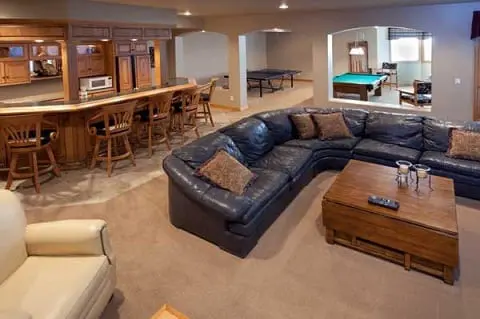
By Joe Provey
Basements are important to Italian Americans. Every time I mention the word “basement” to someone of Italian ancestry, they regale me with stories about how their parents or grandparents kept the upstairs kitchen for show (and perhaps light breakfasts), while the heavy cooking took place in the basement. These basement kitchens were complete with ranges and refrigerators, slicing and grinding machines and big sinks. From them, apparently, an endless stream of roasts, lasagnas, braciola, eggplant parmesan, Easter breads and meat pies were issued forth.
Perhaps this explains why, as an Italian American with the misfortune of having grown up in a house with a crawl space, I head straight to the basement when I’m buying a new house. If it’s not right, I will walk away. Clean and dry basements are in my genes.
The first thing I look for in a basement is evidence of settlement, such as cracks in a wall or slab, and walls that tilt, bulge or bow. While I’m at it, I check for signs of flooding. Water marks on paneling, mold or rot on framing, rust on appliances and ducts and a well-worn sump pump ring my alarm bells. Only after I’m convinced that the foundation and basement are not going to pose major headaches do I head upstairs, where I check out less critical features such as fireplaces, granite countertops, spectacular views or spacious master suites.
Of course, I value a good basement for reasons other than being sound and dry. They can provide much-needed storage space or can be converted to living space. These days, a basement might become a home theater, kid’s play room, home office or spare bedroom, rather than a second kitchen. Dry basements also promote health throughout the rest of the house; mold and mites in a damp basement have plenty of routes to the rooms above.
If you are purchasing a newly built home with a basement, it’s important to speak with your builder about how it will be constructed and water-proofing methods. Also important is to determine how you will use it. Consider a finished space that will serve your family’s needs and one that will add value to your home.
Basement remodeling and makeovers
According to Remodeling Magazine’s annual “Cost vs. Value Report,” the average cost of a mid-range basement remodeling in the United States was $61,303 in 2012. The report suggests that at resale, a homeowner can expect to recoup 70.3 percent of that cost, or $43,095, for a 600-square-foot basement with a wet bar and a 5-by-8-foot full bathroom. That’s a pretty good incentive for a homeowner to take advantage of all that underutilized space, assuming they are planning to stay put for a while.
Less ambitious basement makeovers can net significant returns at resale, too. A partial remodeling that creates a clean and cheery laundry area, for example, is a good investment. So is a spare bedroom with adequate electrical circuits, lighting and emergency egress. At the very least, houses with basements that are useful and free of excess moisture, mold and odors will allow a house to sell faster — and that means more money in a seller’s pocket.
Moving in a year or two?
If you’re planning to sell a house with a basement that has water problems, contact a company that specializes in these kinds of repairs and get the work done as soon as possible.
“Don’t wait until you’re negotiating with a buyer,” says Larry Janesky, president of Basement Systems, Inc., a nationwide network of basement waterproofing dealers founded in 1986 that focuses exclusively on basements and crawlspaces. “Repairs that must be completed under time pressure will invariably end up costing more. Besides, by fixing it now, you can enjoy a dry basement during the remaining time that you live in the house.”
The same advice holds true for foundation problems, such as a settled foundation or slab, a tilted or bowed foundation wall and sagging beam and joists above a crawlspace. Make structural repairs as soon as possible, not when you’re trying to market your house. In addition, seek out a company that can offer a warranty that will reassure prospective home buyers.
If you’re planning to stay put
If you don’t anticipate a move any time soon and you’ve completed any necessary waterproofing or foundation repairs, consider converting your basement to living space to add value to your home.
Ideally, find a contractor who has lots of experience with basements and their unique challenges. You’ll want to consider moisture-resistant products, ranging from wallboard and window replacements to floors and ceilings. They will help you navigate code restrictions, such as minimum ceiling heights and egress requirements. They may even help you design an updated version of an Italian-American basement kitchen and throw a few recipes into the bargain!
To learn more about finished basements and how they are making a comeback, check out our Resource Center article, No Longer Down in the Dungeon: Basements are Back.
Joe Provey is an avid do-it-yourselfer and home improvement writer whose work has appeared on BobVila.com, Houzz.com and DIY Life.